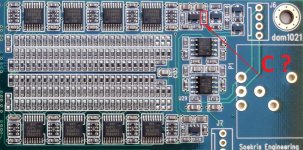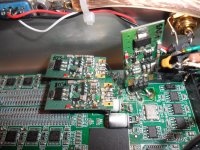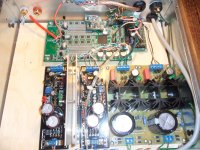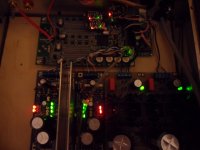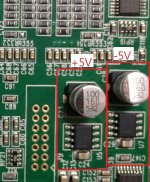In a first test I connected J7 directly to Tessendorf TE10 (3k input) - worked much better than expected.Did anybody here use the raw output and use a buffer stage?
Now I've inserted Sjöström Super Buffer SSB01- better, as expected.
Ulli
A question about the serial interface:
I have TTL level Isolated Serial interface (in J3) always connected for volume control/filter selection. Now I add another RS232 to J10. And I can't type "+++" to enter the setup mode. Is it normal? which means I should disconnect the serial connection in J3 before I connect another serial connection to J10?
Thanks.
I have TTL level Isolated Serial interface (in J3) always connected for volume control/filter selection. Now I add another RS232 to J10. And I can't type "+++" to enter the setup mode. Is it normal? which means I should disconnect the serial connection in J3 before I connect another serial connection to J10?
Thanks.
Hi all.
Still have problem that my dam1021 can't lock signal if it has been powered off for a day or two, need to upload FW(0.99) again to get a lock...MAD!!! Anyone?
Anyway, i did a small PCB to get nice 3.3V for usb, 1.2V and space for a SPDIF transformer (Murata). It use low noise ADM7150 LDO regulator. I use to have a cheap 3.3V standard reg to power usb and input isolators. Nice upgrade i think.
For 1.2V to coax transformer it uses a standard MCP1703-1202.
PCB is 70*30mm.
If anyone need one i have 3 that i don't need.
Regards //Daniel
Still have problem that my dam1021 can't lock signal if it has been powered off for a day or two, need to upload FW(0.99) again to get a lock...MAD!!! Anyone?
Anyway, i did a small PCB to get nice 3.3V for usb, 1.2V and space for a SPDIF transformer (Murata). It use low noise ADM7150 LDO regulator. I use to have a cheap 3.3V standard reg to power usb and input isolators. Nice upgrade i think.
For 1.2V to coax transformer it uses a standard MCP1703-1202.
An externally hosted image should be here but it was not working when we last tested it.
An externally hosted image should be here but it was not working when we last tested it.
PCB is 70*30mm.
If anyone need one i have 3 that i don't need.
Regards //Daniel
It has dropped an object on my DAC and this capacitor is broken.
Does anyone know what capacitor is to order a new one? Thanks a lot.
1u X5R 25V 0603, not that critical decoupling capacitor....
Hi all.
Still have problem that my dam1021 can't lock signal if it has been powered off for a day or two, need to upload FW(0.99) again to get a lock...MAD!!! Anyone?
Anyway, i did a small PCB to get nice 3.3V for usb, 1.2V and space for a SPDIF transformer (Murata). It use low noise ADM7150 LDO regulator. I use to have a cheap 3.3V standard reg to power usb and input isolators. Nice upgrade i think.
For 1.2V to coax transformer it uses a standard MCP1703-1202.
An externally hosted image should be here but it was not working when we last tested it.
An externally hosted image should be here but it was not working when we last tested it.
PCB is 70*30mm.
If anyone need one i have 3 that i don't need.
Regards //Daniel
Try to load firmware and filters best to start with filters recommended by Soekris.
http://www.soekris.dk/1021full_099.skr ----> all firmware/filters
http://www.soekris.dk/1021fpga_099.skr --> fpga firmware
http://www.soekris.dk/1021filt_099.skr ----> dac filters
http://www.soekris.dk/1021_uc_099.skr ---> uC firmware
I had few problems with filters something went wrong when I was messing with them and I couldn't play hi res recordings .
I would like to use either Salas Bib or Salas Reflektor-D for +/-5V resistor ladder voltage supply. Any recommendation on which one I should use? Thanks.
I think the power supply for the ladder will go through the shift registers.
Since the dam uses an opamp to convert to the opposite voltage I dont know how far you can get exact symmetry to a super precision level as the way what is currently being implemented on the board.
One way is that to use only the positive supply so that mirror voltage is created by the precision opamp.
But where does this voltage reference starts? which point? I would like to try this.
I think the power supply for the ladder will go through the shift registers.
Since the dam uses an opamp to convert to the opposite voltage I dont know how far you can get exact symmetry to a super precision level as the way what is currently being implemented on the board.
One way is that to use only the positive supply so that mirror voltage is created by the precision opamp.
But where does this voltage reference starts? which point? I would like to try this.
I am going to replace this part
Just remove the two LDO and capacitors and connect the +/- 5V to the capacitor pads.
Attachments
Try to load firmware and filters best to start with filters recommended by Soekris.
http://www.soekris.dk/1021full_099.skr ----> all firmware/filters
http://www.soekris.dk/1021fpga_099.skr --> fpga firmware
http://www.soekris.dk/1021filt_099.skr ----> dac filters
http://www.soekris.dk/1021_uc_099.skr ---> uC firmware
I had few problems with filters something went wrong when I was messing with them and I couldn't play hi res recordings .
Thanks for the reply. Yes, i was thinking about the filter too, from the start i uploaded "the party pack" filter and was using NewNOS. But since it has been problems from the start i uploaded 1021full_099.skr and are using does filters. But that doesn't solve the problem. Soekris ask me to connect seriell next time i had problems to see what umaneger say.
Best Regards //Daniel
If anyone wants to follow I think nige2000 has come up wit the best way to handle the Vref.
My implementation uses the regulator sold by mravica elsewhere within the VENDORS area. It is two positive regulators using a common ground.
Using the A123 26650 batteries, I am using four, I have removed all of the OEM regulators for the resistor stack. Two of these batteries per channel for the plus and minus supply of each channel. The regulator is connected to its proper side for both channels.
You are limited to 3.3 volts since that is all the batteries should be asked to produce. In this case, the battery is used as a super capacitor; the regulators are always on. One needs a constant voltage, obviously and there is no way to do this with batteries alone.
My setup is producing 3.317 volts for each rail. It doesn't waver at all.
All capacitors are removed. In fact, I have removed just about everything from the board other than the resistor stacks and the shift registers. Suing the HIFIARDUINO method for adding capacitance I use the vias near the shift registers for wiring to the batteries.
This is involved but all in all I think it is simpler to implement than any of the other schemes.
For the input side, the DC-DC converter for the FPGA has been replaced with a BELLESON 1.2 volts regulator. The 3.3 volts reg has been replaced with another A123 battery which is regulated by one of DOEDE's shunt regs set to 3.3 volts. One could use whatever they like, or have on hand, here.
The thing sounds very good but still nowhere close to my LP setup but that is to be expected.
Needless to say comparisons with other approached is impossible but it sounds like a very different, and better, device to my ears.
The lower voltage seems to make no difference at all. It gets louder than I would ever need and it is driving two amplifiers and an active crossover.
I am using a SLAGLE autoformer for volume control.
I uploaded the new firmware in this condition so I know all of that works as intended. There are no drawbacks that I have come across. I have had this operating for a month. I do leave it on since I have not made provision for blocking the batteries from powering the regulators in reverse. There is a switch to turn on the "front end" battery and another pair for turning on the resistor stack batteries, left and right channel. Switch the front end on first and then the resistor stack - easy as that.
I cannot imagine any Vref regulator, alone, bettering this approach. The A123 batteries are quieter and faster than any regulator I am aware of and due to the configuation of the mravica regulator voltages for plus and minus are the same all of the time.
I consider my SOEKRIS finished and I am very pleased with it.
My implementation uses the regulator sold by mravica elsewhere within the VENDORS area. It is two positive regulators using a common ground.
Using the A123 26650 batteries, I am using four, I have removed all of the OEM regulators for the resistor stack. Two of these batteries per channel for the plus and minus supply of each channel. The regulator is connected to its proper side for both channels.
You are limited to 3.3 volts since that is all the batteries should be asked to produce. In this case, the battery is used as a super capacitor; the regulators are always on. One needs a constant voltage, obviously and there is no way to do this with batteries alone.
My setup is producing 3.317 volts for each rail. It doesn't waver at all.
All capacitors are removed. In fact, I have removed just about everything from the board other than the resistor stacks and the shift registers. Suing the HIFIARDUINO method for adding capacitance I use the vias near the shift registers for wiring to the batteries.
This is involved but all in all I think it is simpler to implement than any of the other schemes.
For the input side, the DC-DC converter for the FPGA has been replaced with a BELLESON 1.2 volts regulator. The 3.3 volts reg has been replaced with another A123 battery which is regulated by one of DOEDE's shunt regs set to 3.3 volts. One could use whatever they like, or have on hand, here.
The thing sounds very good but still nowhere close to my LP setup but that is to be expected.
Needless to say comparisons with other approached is impossible but it sounds like a very different, and better, device to my ears.
The lower voltage seems to make no difference at all. It gets louder than I would ever need and it is driving two amplifiers and an active crossover.
I am using a SLAGLE autoformer for volume control.
I uploaded the new firmware in this condition so I know all of that works as intended. There are no drawbacks that I have come across. I have had this operating for a month. I do leave it on since I have not made provision for blocking the batteries from powering the regulators in reverse. There is a switch to turn on the "front end" battery and another pair for turning on the resistor stack batteries, left and right channel. Switch the front end on first and then the resistor stack - easy as that.
I cannot imagine any Vref regulator, alone, bettering this approach. The A123 batteries are quieter and faster than any regulator I am aware of and due to the configuation of the mravica regulator voltages for plus and minus are the same all of the time.
I consider my SOEKRIS finished and I am very pleased with it.
I have listening for two days and i can say that change 5v stock stabilizers for better discrets Muzg special stabilizers change couple of thinks
-more deep and wide sound stage
-better 3d imagination of instruments
-litle more details
-more dynamic sound
I was good and cheap mode. But what now? mayby it is over of moding? I dont know that. Still thinking about change recifilter diodes in power supply for like i was writing before Lt4320 bridge kontroler. Stil trying to find it is sense to use it in audio.
-more deep and wide sound stage
-better 3d imagination of instruments
-litle more details
-more dynamic sound
I was good and cheap mode. But what now? mayby it is over of moding? I dont know that. Still thinking about change recifilter diodes in power supply for like i was writing before Lt4320 bridge kontroler. Stil trying to find it is sense to use it in audio.
I just don't have time to update the vref posts at the moment, so I've taken them down.
There are some issues with the sims of the vref, to the point I think it's safe to say any sim that hasn't been verified by real world testing should be treated with a healthy amount of scepticism.
What I've found is that the .noise sims tally up in terms of broad trends with the white noise testing of the vref. This is because the white noise is basically a steady state load, and the vref buffer is not subject to the same kind of load variation as with sine or square wave tests.
Once you start looking at more dynamic test signals the sims become significantly less accurate. It has been pointed out by zfe and others that the load presented to the vref by the shift registers and R2R ladder is very complex, so it's not so surprising that it's difficult to simulate dynamic loading accurately.
I'm finding with the low-res mod and 2700uF per vref that there is a loss of dynamics, which is one of the reasons I was looking at possibility of using staggered cap values, rather than 4 or 5 x single value. I want to take a look at the bc560/550 mod at some point to see if this helps, but I want to do before//after measurements to see what effect this mod actual has.
The other niggle is the "super reg" supply I'm using is still dumping crap into the ground of the DAM at low level despite having replaced virtually everything except the transformer. The noise is high enough that it just breaks through above the level of ripple on the vref when playing back white noise. For the square and sine tests, the noise is actually a dominant factor in the vref posts so makes it hard to see what is going on. I'm still clinging to the faint glimmer of hope it's my build not the design, but I'm running out of part replacement options.
Have you had any luck with your SSR04 "super reg"? I believe you mentioned in one thread that you thought it might be one of the pass transistors. I am curious what type of crap you are seeing out of it? I was contemplating using one for a DAM build.
Thanks for the update, I just ordered someI have listening for two days and i can say that change 5v stock stabilizers for better discrets Muzg special stabilizers change couple of thinks
Also an extra 3.3vdc for powering the Amanero instead of USB power.
- Home
- Vendor's Bazaar
- Reference DAC Module - Discrete R-2R Sign Magnitude 24 bit 384 KHz
